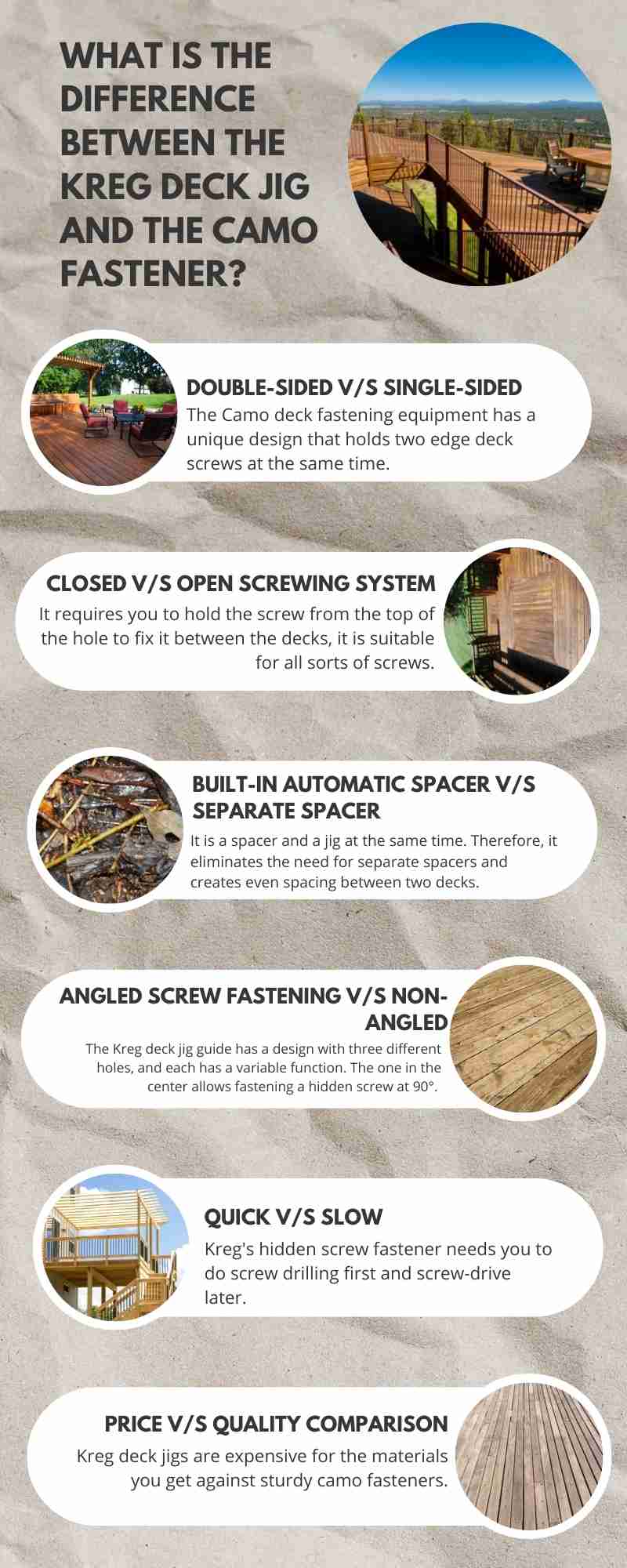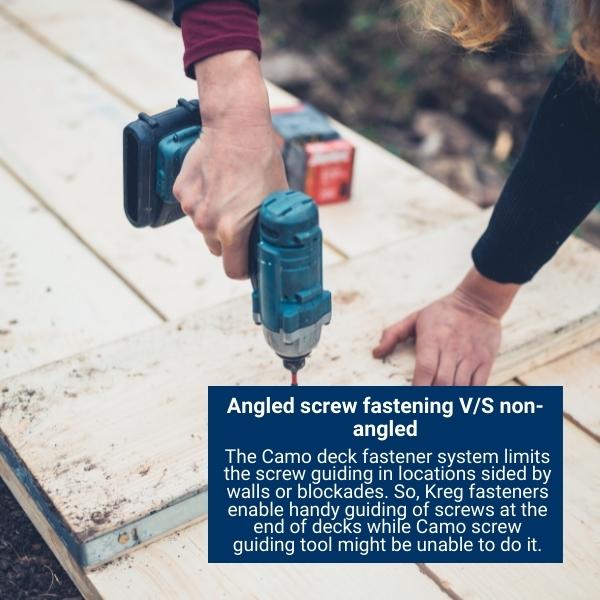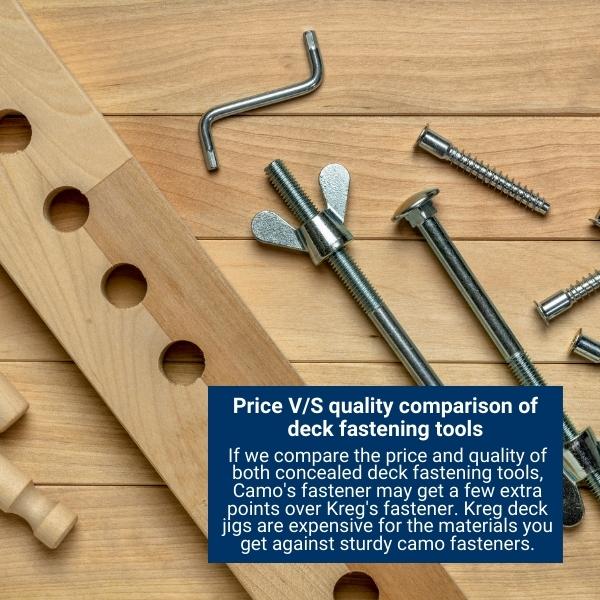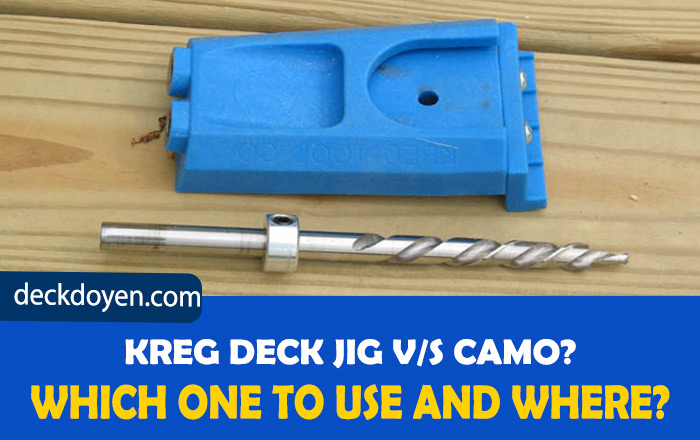Are you planning to set up a new deck floor shortly to give your property an esthetic appearance without visible fasteners? Hidden deck fasteners can help you finish it with deck boards without visibly unappealing screws. You can either use a Kreg deck jig or Camo fastener. However, it is not straightforward to decide which one to use and where?
A Kreg deck jig is a plastic-made single-side deck fastening system with two angled holes for fastening screws at the end of the deck. It includes a drill bit, a driver bit, a few screws, and two stop collars. In contrast, the Camo marksman fastener is a dual-side hidden fastening clamp for accurate edge screw guiding keeping your hands free. However, it is hard to use at the end of the decks.
Both of these are suitable for efficient fastening of the screw-free deck surfaces. Still, they both have different operating methods and applications. Hence, I have authored this to help you know the comparative usage and pros and cons of Kreg’s and camo’s deck fasteners. Let’s dig in more to know about it.
What Is The Difference Between The Kreg Deck Jig And The Camo Fastener?
The usual fastening methods with numerous screws and nails visual on the surface result in a non-attractive look of the deck surface. So a hidden fastening system is your best pick to make your wooden or composite deck look elegant. It can save much time and hassle because they provide an automatic spacing system and a lesser need for nailing. Moreover, the deck surface will be free from inaccurate spacing, irregular screws, and unwanted silvers.

However, both Camo and Kreg deck fasteners are the best fasteners to do the task appropriately. So before you pick any of them blindly, read how and where to use them. Let’s compare the price, quality, durability, and manageability of these two.
Also Read: Best Decking Material For Winter
Double-Sided vs Single-Sided:
The Camo deck fastening equipment has a unique design that holds two edge deck screws at the same time. It allows dual-sided screwing without changing the direction of your fastener. In contrast, Kreg deck jigs have anglers at one side only. You will have to rotate it if you want to fasten the other side of the deck.
Closed vs Open Screwing System:
Kreg hidden screw deck fastener is a flat open and plastic tool. Though It requires you to hold the screw from the top of the hole to fix it between the decks, it is suitable for all sorts of screws. However, the Camo fastener is a closed system in which you can place two screws at the same time. It keeps your hand free while drilling, and you don’t have to hold the bolt. Still, the drawback is that It only works with Camo edge deck screws.
Also Read: How To Lay Decking On Grass? Step By Step Guide!
Built-In Automatic Spacer vs Separate Spacer
Camo manufacturer has designed it with incredible thoughtfulness for effortless usage. It is a spacer and a jig at the same time. Therefore, it eliminates the need for separate spacers and creates even spacing between two decks. The Kreg deck jig has detached spacers for spacing between the deck boards. However, in the package of the Kreg fastener, you get two sets of spacing tools for variable spacing. Each bunch has three 5/16 inches and 1/4 inches thick spacing rings. So, you can create spacing according to your preferred thickness, which is impossible with Camo fasteners.
Kreg Screw Length And Kreg Jig Setting:
Specification | WEED Membrane | WEED Membrane ULTRA |
Average mean or pore size | 43μ | 33μ |
Light transmittance | <8.0% | <4.0% |
Carbon black content | 3.0% | 3.0% |
Membrane weight | 50gsm | 70gsm |
Guaranteed life – when covered | 15 years | 25 years |
Note: It is important to mark that the screw length is measured from the bottom of the head all the way to the tip.
Camo Fastener Size And Deck board Thickness:
Nominal Deckboard Product | Recommended Fastener Size | Actual Board Thickness Range |
5/4″ | 1-7/8″ (48mm) | 3/4″ (19mm) – 1-1/4″ (32mm) |
2x | 2-3/8″ (60mm) | 1-1/2″ (38mm) |
This table provides an easy reference guide for selecting the proper CAMO Fastener size based on nominal deckboard product and actual board thickness.
Note: I recommend following these guidelines to ensure the best possible installation and long-lasting performance. For boards that exceed 1″ in actual thickness, we recommend a 2-3/8” fastener. However, for any board thicker than 1-1/2”, we do not recommend using the 2-3/8” CAMO fastener.
Angled Screw Fastening vs Non-Angled:
The Kreg deck jig guide has a design with three different holes, and each has a variable function. The one in the center allows fastening a hidden screw at 90°. Besides, it has side holes for 45° screw drilling at hard places with walls or support on the sides.

However, the Camo deck fastener system limits the screw guiding in locations sided by walls or blockades. So, Kreg fasteners enable handy guiding of screws at the end of decks while Camo screw guiding tool might be unable to do it.
Quick vs Slow:
Time is an essential factor that may help you decide on one of the two tools. Camo deck jig has a screw holding space that you don’t need to drill and drive separately. On the other hand, Kreg’s hidden screw fastener needs you to do screw drilling first and screw-drive later. So, it takes a little more time to fasten the deck because you need to replace the bits for different functions. Camo screw guide saves you from the hassle of changing the bits and saves a lot of time for you.
Also Read: How Long To Wait Before Staining Pressure Treated Wood
Price vs Quality Comparison:
After comparing the price and quality of both concealed deck fastening tools, Camo’s fastener may get a few extra points over Kreg’s fastener. Both of them are head to head in terms of quality and long-lasting. Regardless, Kreg deck jigs are expensive for the materials you get against sturdy camo fasteners. Besides, it’s also flimsy and moves a little bit while drilling.

Conclusion:
In a nutshell, both products are comparatively neck-in-neck with each other. However, notable reasons can make one of them preferable to the other.
Kreg deck jig is a complete package that includes all the necessary tools to make your deck surface look free from all ugly screws. It is a bit shaky with a long time of operation. That’s why it is suitable for small deck fastening tasks of composite or wooden materials.
On the other hand, Camo is a high-quality, all-in-one deck board fastener that is handy and durable. It has two built-in screw holding spaces and dual side deck spacer for manageable functionality. So, if you are a contractor, this product is for you.
Also Read: Should A Deck Be Level Or Sloped?
Does Kreg’s Hidden Deck Fastener Require Pre-Drilling?
Yes, it needs pre-drilling as it is an open system, workable with screws of all brands. Therefore, you must use a drilling bit with its depth stop collar. It will keep your drilling precise to a certain depth.
Are Kreg’s Deck Jigs Usable For Composite Decking? Is It Better Than The Camo?
You can use the deck fastener tool for any decking material. While it goes well with a composite material, it still works best for treated cedar wood or plastic decks. It has a splinter and cracks-free result without zero indication of pop-out. So, it does give your deck surface a clean and finished surface regardless of the material.
CAMO Material Selection:
Recommended Coating/Alloy | Deckboard Material |
CAMO 316 Stainless Steel Alloy | Cedar |
CAMO 316 Stainless Steel Alloy | Redwood |
CAMO 316 Stainless Steel Alloy | Hardwood or Impoted Harwood |
CAMO ProTech Coated Carbon Steel | Pressure Treated |
CAMO ProTech Coated Carbon Steel | PVC |
CAMO ProTech Coated Carbon Steel | LumberComposite/ Capped Composite |
Why Does The Camo Fastener Get Stuck On The Deck?
When you don’t drive the camo fastener into the joist, Your hidden deck fastening tool gets stuck between the boards. To unclamp, you need to unscrew it by reversing the drill. Otherwise, the fastener will break if pulled too strongly without unscrewing it.
How Many Screws Are Necessary For An Enduring Deck Fitting?
Screws are the only support that keeps your deck boards standing in their place for years. It enables your deck to withstand all the external pressure, so you must use an accurate number of screws. It is suggested to use two screws between the crossing of two boards and three at the rim joist. It will be enough to secure your deck for a more extended period.
Also Read: How To Protect Your Deck From The Weather?

